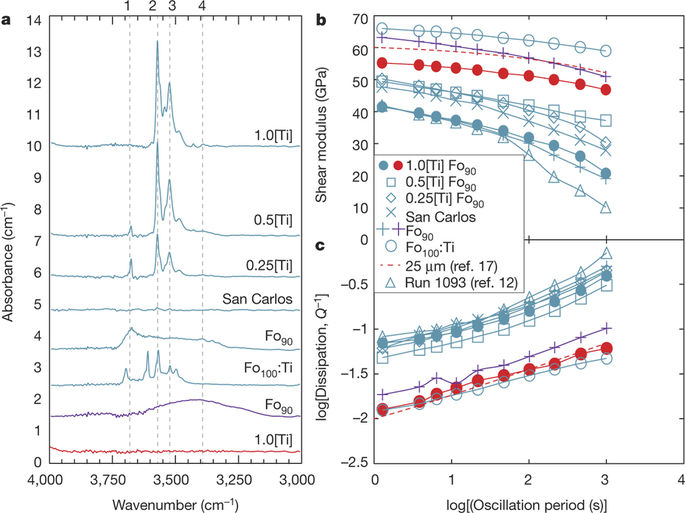Our official English website, www.x-mol.net, welcomes your feedback! (Note: you will need to create a separate account there.)
Redox-influenced seismic properties of upper-mantle olivine
Nature ( IF 64.8 ) Pub Date : 2018-03-01 , DOI: 10.1038/nature25764 C. J. Cline II , U. H. Faul , E. C. David , A. J. Berry , I. Jackson
Nature ( IF 64.8 ) Pub Date : 2018-03-01 , DOI: 10.1038/nature25764 C. J. Cline II , U. H. Faul , E. C. David , A. J. Berry , I. Jackson

|
Lateral variations of seismic wave speeds and attenuation (dissipation of strain energy) in the Earth’s upper mantle have the potential to map key characteristics such as temperature, major-element composition, melt fraction and water content. The inversion of these data into meaningful representations of physical properties requires a robust understanding of the micromechanical processes that affect the propagation of seismic waves. Structurally bound water (hydroxyl) is believed to affect seismic properties but this has yet to be experimentally quantified. Here we present a comprehensive low-frequency forced-oscillation assessment of the seismic properties of olivine as a function of water content within the under-saturated regime that is relevant to the Earth’s interior. Our results demonstrate that wave speeds and attenuation are in fact strikingly insensitive to water content. Rather, the redox conditions imposed by the choice of metal sleeving, and the associated defect chemistry, appear to have a substantial influence on the seismic properties. These findings suggest that elevated water contents are not responsible for low-velocity or high-attenuation structures in the upper mantle. Instead, the high attenuation observed in hydrous and oxidized regions of the upper mantle (such as above subduction zones) may reflect the prevailing oxygen fugacity. In addition, these data provide no support for the hypothesis whereby a sharp lithosphere–asthenosphere boundary is explained by enhanced grain boundary sliding in the presence of water.
中文翻译:

上地幔橄榄石受氧化还原影响的地震性质
地球上地幔中地震波速度和衰减(应变能耗散)的横向变化有可能绘制关键特征,如温度、主要元素组成、熔体分数和含水量。将这些数据反演为有意义的物理特性表示需要对影响地震波传播的微机械过程有深入的了解。结构结合水(羟基)被认为会影响地震特性,但这尚未通过实验量化。在这里,我们对橄榄石的地震特性进行了全面的低频强迫振荡评估,作为与地球内部相关的欠饱和区域内含水量的函数。我们的结果表明,波速和衰减实际上对含水量非常不敏感。相反,由金属套管的选择和相关的缺陷化学所施加的氧化还原条件似乎对地震性能有重大影响。这些发现表明,水含量升高并不是造成上地幔低速或高衰减结构的原因。相反,在上地幔的含水和氧化区域(例如俯冲带上方)观察到的高衰减可能反映了普遍的氧逸度。此外,这些数据不支持通过在水存在下增强的晶界滑动来解释尖锐的岩石圈-软流圈边界的假设。金属套管的选择所施加的氧化还原条件,以及相关的缺陷化学,似乎对抗震性能有重大影响。这些发现表明,水含量升高并不是造成上地幔低速或高衰减结构的原因。相反,在上地幔的含水和氧化区域(例如俯冲带上方)观察到的高衰减可能反映了普遍的氧逸度。此外,这些数据不支持通过在水存在下增强的晶界滑动来解释尖锐的岩石圈-软流圈边界的假设。金属套管的选择所施加的氧化还原条件,以及相关的缺陷化学,似乎对抗震性能有重大影响。这些发现表明,水含量升高并不是造成上地幔低速或高衰减结构的原因。相反,在上地幔的含水和氧化区域(例如俯冲带上方)观察到的高衰减可能反映了普遍的氧逸度。此外,这些数据不支持通过在水存在下增强的晶界滑动来解释尖锐的岩石圈-软流圈边界的假设。这些发现表明,水含量升高并不是造成上地幔低速或高衰减结构的原因。相反,在上地幔的含水和氧化区域(例如俯冲带上方)观察到的高衰减可能反映了普遍的氧逸度。此外,这些数据不支持通过在水存在下增强的晶界滑动来解释尖锐的岩石圈-软流圈边界的假设。这些发现表明,水含量升高并不是造成上地幔低速或高衰减结构的原因。相反,在上地幔的含水和氧化区域(例如俯冲带上方)观察到的高衰减可能反映了普遍的氧逸度。此外,这些数据不支持通过在水存在下增强的晶界滑动来解释尖锐的岩石圈-软流圈边界的假设。
更新日期:2018-03-01
中文翻译:

上地幔橄榄石受氧化还原影响的地震性质
地球上地幔中地震波速度和衰减(应变能耗散)的横向变化有可能绘制关键特征,如温度、主要元素组成、熔体分数和含水量。将这些数据反演为有意义的物理特性表示需要对影响地震波传播的微机械过程有深入的了解。结构结合水(羟基)被认为会影响地震特性,但这尚未通过实验量化。在这里,我们对橄榄石的地震特性进行了全面的低频强迫振荡评估,作为与地球内部相关的欠饱和区域内含水量的函数。我们的结果表明,波速和衰减实际上对含水量非常不敏感。相反,由金属套管的选择和相关的缺陷化学所施加的氧化还原条件似乎对地震性能有重大影响。这些发现表明,水含量升高并不是造成上地幔低速或高衰减结构的原因。相反,在上地幔的含水和氧化区域(例如俯冲带上方)观察到的高衰减可能反映了普遍的氧逸度。此外,这些数据不支持通过在水存在下增强的晶界滑动来解释尖锐的岩石圈-软流圈边界的假设。金属套管的选择所施加的氧化还原条件,以及相关的缺陷化学,似乎对抗震性能有重大影响。这些发现表明,水含量升高并不是造成上地幔低速或高衰减结构的原因。相反,在上地幔的含水和氧化区域(例如俯冲带上方)观察到的高衰减可能反映了普遍的氧逸度。此外,这些数据不支持通过在水存在下增强的晶界滑动来解释尖锐的岩石圈-软流圈边界的假设。金属套管的选择所施加的氧化还原条件,以及相关的缺陷化学,似乎对抗震性能有重大影响。这些发现表明,水含量升高并不是造成上地幔低速或高衰减结构的原因。相反,在上地幔的含水和氧化区域(例如俯冲带上方)观察到的高衰减可能反映了普遍的氧逸度。此外,这些数据不支持通过在水存在下增强的晶界滑动来解释尖锐的岩石圈-软流圈边界的假设。这些发现表明,水含量升高并不是造成上地幔低速或高衰减结构的原因。相反,在上地幔的含水和氧化区域(例如俯冲带上方)观察到的高衰减可能反映了普遍的氧逸度。此外,这些数据不支持通过在水存在下增强的晶界滑动来解释尖锐的岩石圈-软流圈边界的假设。这些发现表明,水含量升高并不是造成上地幔低速或高衰减结构的原因。相反,在上地幔的含水和氧化区域(例如俯冲带上方)观察到的高衰减可能反映了普遍的氧逸度。此外,这些数据不支持通过在水存在下增强的晶界滑动来解释尖锐的岩石圈-软流圈边界的假设。



























 京公网安备 11010802027423号
京公网安备 11010802027423号